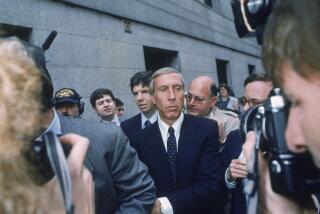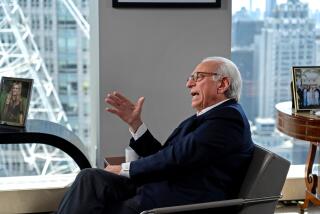Strategy Shift Kept Deal From Dissolving
NEW YORK — Eliot Spitzer was fed up.
The New York attorney general had spent months haggling with Wall Street’s most powerful securities firms over a proposed industrywide settlement of stock analyst conflicts of interest, and a deal that seemed within reach a few days earlier was in danger of falling apart.
The brokerage houses were objecting to the size of the fines they were being told to pay, and they seemed intent on delaying the talks into the new year. That infuriated Spitzer and other weary regulators, who wanted a deal by Christmas.
To break the stalemate, regulators huddled Dec. 16 and came up with a two-pronged strategy, according to interviews with some of the key participants.
They decided to focus most intently on working out a deal with Wall Street’s top five firms -- Citigroup Inc., Credit Suisse First Boston, Merrill Lynch & Co., Goldman Sachs Group Inc. and Morgan Stanley.
“At that point,” one regulator recalled, “we were willing to say, ‘Let’s do a subset of the firms now, and the rest later.’ ”
At a minimum, the regulators figured, any sort of pact would allow them to claim a victory in their months-long effort to forge a “global” settlement.
They also were betting that striking an agreement with the larger firms would squeeze four smaller brokerages -- Lehman Bros. Holdings, UBS Warburg, Deutsche Bank and Bear Stearns Cos. -- into signing on.
A pact with the five big firms, said one regulator, would “put an incredible amount of pressure on the other four.”
Despite their size, the smaller firms posed a significant threat to the broad settlement because their opposition was more strident, and they seemed more willing to walk away from the bargaining table.
As the days passed, regulators also adopted a more urgent and threatening tone. Agree to a deal immediately, they told the firms, or face years of withering court battles.
“You would have one regulator read a firm the riot act, and then find out that another regulator did the same thing 20 minutes later,” one official said.
The stern message was delivered most forcefully Wednesday, when Spitzer summoned high-ranking executives of the five firms to his office and bluntly told them to get on board that day.
The hardball tactics worked.
On Friday, Spitzer and other regulators announced a settlement that included the biggest securities-related fines in U.S. history and some of the most sweeping reforms ever on Wall Street.
Pending the signing of final documents in the next few weeks, 10 companies, including J.P. Morgan Chase & Co., would fork over $1.4 billion in penalties and other fines and revamp the rules governing stock analysts.
But persuading the firms to sign off on the deal was only part of the battle. Spitzer faced dissension within his own ranks as securities regulators in some states -- most notably California -- thought their counterparts were conceding too much in their rush to do a deal.
Demetrios A. Boutris, commissioner of the California Department of Corporations, publicly broke ranks with his counterparts in late November by declaring that each firm should pay at least $100 million -- double the amount sought from several of the brokerages.
California had led the probe of Deutsche Bank, and Boutris was especially adamant that the German company be fined at least $100 million. He met stiff resistance from his fellow regulators, who argued that the evidence supported a $50-million fine.
The opposition from Boutris was significant because one of his top deputies was co-chairing a task force of states probing analyst conflicts and because California’s size gave it clout in shaping a final deal.
Boutris eventually relented after personal entreaties from Spitzer and New York Stock Exchange Chairman Richard Grasso, who lobbied him in four phone calls Tuesday and Wednesday.
Yet no sooner had Boutris backed down than grousing was heard from another quarter: Matthew Nestor, senior securities regulator for Massachusetts, complained in a Wednesday e-mail to his counterparts that the government had relaxed its settlement demands too quickly.
“It was with great reluctance that we immediately moved from $250 to $150 million approx. a week ago,” Nestor wrote, referring to the fine demanded of CSFB, the investigation of which was handled by Massachusetts.
Nestor noted that he had made it clear he would go “no lower” than $150 million, and he was incensed when other regulators went to CSFB with an offer of $125 million.
“We were not consulted or advised about this change until after it was transmitted to CSFB,” Nestor wrote. “This breach of protocol is astonishing and unacceptable.”
CSFB eventually agreed to pay $150 million. Nestor declined to comment Sunday.
Although reconciling the interests of 50 states presented problems, their participation also yielded dividends.
State regulators, who have long worked in the shadow of their national counterparts at the Securities and Exchange Commission, were intent on proving their mettle.
This was especially so because of the lack of respect that some state officials believed they were accorded by those on Wall Street. A regulator in one state said he heard through the grapevine that executives at one brokerage had actually cheered after learning that his state would lead the probe of their company.
“They thought, ‘There’s no way these underpaid state employees going up against $400-an-hour lawyers could put this case together,” said another regulator, Joe Borg, the Alabama securities chief who spearheaded the Lehman Bros. probe. “That was a big motivator.”
At one meeting last week, Borg recounted, he and his counterpart from the SEC turned to Lehman’s lawyers and said, “OK, we’ll see you in federal court on Tuesday and state court on Wednesday.”
NYSE Chairman Grasso played a key behind-the-scenes role throughout, sources said.
Efforts to reach a settlement initially were hampered by a feud between Spitzer and then-SEC Chairman Harvey L. Pitt.
Spitzer’s investigation of Merrill Lynch analysts last spring, which ended with the firm assenting to a $100-million fine, had kick-started the broader analyst inquiry. The SEC worried that Spitzer would overstep his boundaries and usurp its authority to set national market standards. Spitzer fretted that Pitt would not be tough enough on Wall Street.
Those differences were smoothed over at a meeting convened by Grasso in October.
Grasso also was instrumental in prodding the recalcitrant firms to come to the table in the final week, one source said. While Spitzer focused on the five largest firms, Grasso lobbied the four smaller ones.
SEC enforcement chief Stephen Cutler played a central role as well, one official said, relaying offers between the two sides like a State Department envoy practicing shuttle diplomacy.
In the end, regulators said, the firms got the message that it was time to do a deal.
“What brought it across the finish line,” one official said, “was the regulators said, ‘We’re done. We’ve talked enough.’ ”
*
Times staff writer Thomas S. Mulligan contributed to this report.
More to Read
Inside the business of entertainment
The Wide Shot brings you news, analysis and insights on everything from streaming wars to production — and what it all means for the future.
You may occasionally receive promotional content from the Los Angeles Times.










